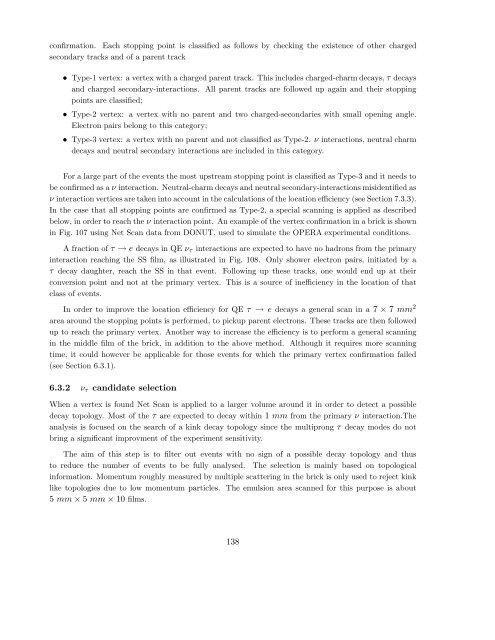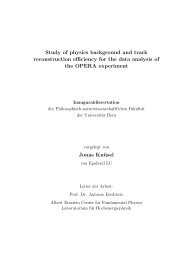Experiment Proposal - opera - Infn
Experiment Proposal - opera - Infn
Experiment Proposal - opera - Infn
You also want an ePaper? Increase the reach of your titles
YUMPU automatically turns print PDFs into web optimized ePapers that Google loves.
confirmation. Each stopping point is classified as follows by checking the existence of other charged<br />
secondary tracks and of a parent track<br />
• Type-1 vertex: a vertex with a charged parent track. This includes charged-charm decays, τ decays<br />
and charged secondary-interactions. All parent tracks are followed up again and their stopping<br />
points are classified;<br />
• Type-2 vertex: a vertex with no parent and two charged-secondaries with small opening angle.<br />
Electron pairs belong to this category;<br />
• Type-3 vertex: a vertex with no parent and not classified as Type-2. ν interactions, neutral charm<br />
decays and neutral secondary interactions are included in this category.<br />
For a large part of the events the most upstream stopping point is classified as Type-3 and it needs to<br />
be confirmed as a ν interaction. Neutral-charm decays and neutral secondary-interactions misidentified as<br />
ν interaction vertices are taken into account in the calculations of the location efficiency (see Section 7.3.3).<br />
In the case that all stopping points are confirmed as Type-2, a special scanning is applied as described<br />
below, in order to reach the ν interaction point. An example of the vertex confirmation in a brick is shown<br />
in Fig. 107 using Net Scan data from DONUT, used to simulate the OPERA experimental conditions.<br />
Afractionofτ → e decays in QE ν τ interactions are expected to have no hadrons from the primary<br />
interaction reaching the SS film, as illustrated in Fig. 108. Only shower electron pairs, initiated by a<br />
τ decay daughter, reach the SS in that event. Following up these tracks, one would end up at their<br />
conversion point and not at the primary vertex. This is a source of inefficiency in the location of that<br />
class of events.<br />
In order to improve the location efficiency for QE τ → e decays a general scan in a 7 × 7 mm 2<br />
area around the stopping points is performed, to pickup parent electrons. These tracks are then followed<br />
up to reach the primary vertex. Another way to increase the efficiency is to perform a general scanning<br />
in the middle film of the brick, in addition to the above method. Although it requires more scanning<br />
time, it could however be applicable for those events for which the primary vertex confirmation failed<br />
(see Section 6.3.1).<br />
6.3.2 ν τ candidate selection<br />
When a vertex is found Net Scan is applied to a larger volume around it in order to detect a possible<br />
decay topology. Most of the τ are expected to decay within 1 mm from the primary ν interaction.The<br />
analysis is focused on the search of a kink decay topology since the multiprong τ decay modes do not<br />
bring a significant improvment of the experiment sensitivity.<br />
The aim of this step is to filter out events with no sign of a possible decay topology and thus<br />
to reduce the number of events to be fully analysed. The selection is mainly based on topological<br />
information. Momentum roughly measured by multiple scattering in the brick is only used to reject kink<br />
like topologies due to low momentum particles. The emulsion area scanned for this purpose is about<br />
5 mm × 5 mm × 10 films.<br />
138




